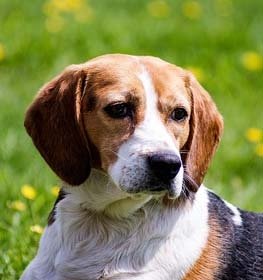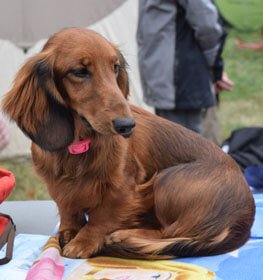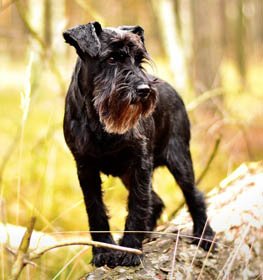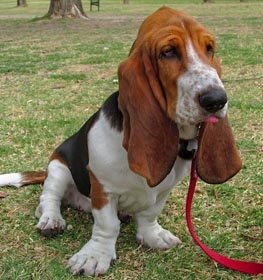Xoloitzcuintli Information & Dog Breed Facts
Collection of all the general dog breed info about Xoloitzcuintli so you can get to know the breed more.
| Group | Hunting Dogs |
|---|---|
| Popularity Rank | 143 |
| Reviews | 2 |
| User Ratings | |
|
Compare the Xoloitzcuintli With Other Dogs
Select at least one dog breed to make the comparsion. | |
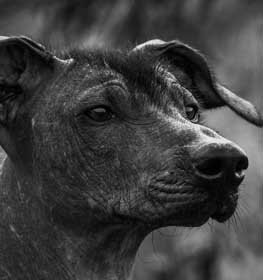 | |
| Origin | |
|
Common Names & Aliases
What other names is a Xoloitzcuintli known by? Discover all traditional, regional and informal names used for this breed. | XolitoXoloXoloescuincleXoloitzcuintleXoloitzcuintliXoloitzquintleMexican Hairless |
|---|---|
|
Breed Classification
What type of dog breed is a Xoloitzcuintli? Learn about its genetic classification and breeding category. | Purebred |
|
Size Classification
What size category is a Xoloitzcuintli? Learn how big the Xoloitzcuintli breed typically grows. | Medium |
|---|---|
|
Weight Statistics
How much does a Xoloitzcuintli weigh? Discover typical weight ranges for adult males and females of the Xoloitzcuintli breed. | 15-30 pounds (7-14 kg) |
|
Average Weight
What is the average weight of a Xoloitzcuintli? | 22.5 pounds (10.5 kg) |
|
Height
How tall is the Xoloitzcuintli? Xoloitzcuintli height: | 15-20 inches (38-51 cm) |
|
Average Height
What is the average height of a Xoloitzcuintli? | 17.5 inches (44.5 cm) |
|
Price Range
How much does a Xoloitzcuintli puppy cost? Find current market prices and factors affecting Xoloitzcuintli costs. | $600-$800 If you choose to purchase the Xoloitzcuintli, you should know that the mentioned amount of money is an average of the collected data from breeders’ sites and puppy finder places. If you have a Xoloitzcuintli for sale, please advertise it on a reliable website to make sure the Xoloitzcuintli gets to a happy place. |
|---|---|
|
Availability
How easy is it to get a Xoloitzcuintli? How many Xoloitzcuintli are there in the world? | Frequent: The Xoloitzcuintli is easier than average to get. Maybe there is some risk of overbreeding, as it is a popular breed. Due to its popularity, inbreeding may occur. A new study shows that inbreeding contributes to the incidence of disease and health problems. So be careful and seek the help of an experienced person or a professional, in making your decision. |
|
Intelligence Rating
How intelligent is a Xoloitzcuintli? Discover the Xoloitzcuintli's intelligence ranking and learning capabilities. | Low to average: This canine intelligence is not the brightest one. Keep in mind that if you want to teach them any tricks, they understand and memorize new commands in 40-80 repetitions. Xoloitzcuintli obey the first command 30% of the time or better. So if you want to have a smart dog, you might have to reconsider your choice with this breed.
The Xoloitzcuintli ranks below average in the intelligence ranking of dogs. |
|---|---|
|
Training Difficulty
How easy is it to train a Xoloitzcuintli? Learn about the Xoloitzcuintli's trainability and response to training methods. | Xoloitzcuintli dogs are quite easy to train. Sometimes they can be challenging, but if you're consistent in teaching new commands they will obey for sure. |
|
Watchdog Rating
How good is a Xoloitzcuintli as a watchdog? Learn about the Xoloitzcuintli's alertness and guarding instincts. | Xoloitzcuintli dogs are average watchdogs. If they sense something different, they will alert you, but observation isn't considered their main job.
|
|
Territorial Protection
Is a Xoloitzcuintli protective of its territory? Learn about the Xoloitzcuintli's guarding instincts and behavior. | Xoloitzcuintli dogs are not the best to protect their territory. Better to have the protection of your house and property supervised by others. |
|
Personality Traits
What personality does a Xoloitzcuintli have? Learn about characteristic Xoloitzcuintli temperament and behavior traits. | ProtectiveAlertLoyalCompanionableCheerfulCalm |
|---|---|
|
Sensitivity Level
How sensitive are they? Xoloitzcuintli sensitivity: | Sensitive: Xoloitzcuintli dogs don't like an irregular daily routine, noisy household, and frequent guest visits.
This breed's emotional level reflects their owner's feelings and they don't handle punishments well. |
|
Affection Level
How affectionate are they? Is a Xoloitzcuintli a good family dog? | High: Xoloitzcuintli dogs are genuinely loyal, soft and gentle, loving, and affectionate dogs toward their handlers. They enjoy quality time with their owners despite the activity and are considered great therapy dogs for those in need. This breed responds strongly to their handler's emotions because they bond closely. Their happiness is your happiness. |
|
Social Needs
How much social interaction does the Xolito need? Xoloitzcuintli social needs: | Xoloitzcuintli dogs need a lot of social interaction. They desire to always be with someone or around people. This breed hates being left alone. |
|
Impulse to Wander or Roam
How likely is the Xoloitzcuintli to run away? Does this breed explore or wander a lot? Does Xoloitzcuintli roam? | The wanderlust potential of the Xoloitzcuintli is strong enough to escape from home. They have a strong desire for exploring the world. Safer to walk them on a leash unless you teach them how to get back to you on command. |
|
Prey Drive
Do this canine have a strong prey drive? Does Xoloitzcuintli have high prey drive? | Xoloitzcuintli dogs have a higher impulse to chase and catch something than other dog breeds. Cats or any other small animals might be in danger. It's a natural instinct, doesn't necessarily mean that Xoloitzcuintli dogs are aggressive. Better to keep this breed on a leash. |
|
Barking Frequency
Does a Xoloitzcuintli bark a lot? Learn about typical Xoloitzcuintli vocalization patterns and triggers. | Low: The Xoloitzcuintli barks none to minimal. Perfect choice if you prefer a quiet breed.
Top reasons for barking: protection, alarm, fear, boredom, attention-seeking, greeting, separation anxiety, compulsive barking. |
|---|---|
|
Playful Nature
How playful is a Xoloitzcuintli? Understand the typical play drive and energy level of the Xoloitzcuintli breed. | Average: Xoloitzcuintlis, like any other dog breed, like playing. Sometimes they bark in excitement for playing, but they are not the most playful dog breed. |
|
Apartment Adaptability
Can a Xoloitzcuintli live in an apartment? Learn about the Xoloitzcuintli's suitability for apartment living. | Very house-friendly dog the Xoloitzcuintli breed. It's good if you have a small garden where he can go out and do his business, but it's not important at all. You can get enough exercise with one or two walks a day, so keeping them indoors shouldn't be a problem. |
|
Lifestyle Adaptability
How adaptable is a Xoloitzcuintli to lifestyle changes? Learn about the Xoloitzcuintli's flexibility to new situations. | Xoloitzcuintli dogs adapt very well to lifestyle changes and basically all living environments. They don't mind moving from one place to another with their owner. |
|---|---|
|
Alone Time Tolerance
Can a Xoloitzcuintli be left alone? Learn about the Xoloitzcuintli's tolerance to solitude. | Xoloitzcuintli dogs tend to have separation anxiety when their owners left them alone at home because they bond very closely with them. |
|
Bite Risk Assessment
What is a Xoloitzcuintli biting potential? Learn about the Xoloitzcuintli's bite risk factors. | Low 🔽 The Xoloitzcuintli has a low chance of biting somebody. Top reasons for dog bite: protection, pain, excitement, herding instinct, being provoked. (Data based on the available online bite statistics.) |
|---|---|
|
Mouthing Tendency
Is a Xoloitzcuintli mouthy? Learn about the Xoloitzcuintli's tendency to use mouth during play. | Xoloitzcuintli dogs have a higher than average tendency to nip, chew, playbite, or herd people. It's a common habit during puppyhood, not aggressive behavior. These "bites" don't hurt, but Xoloitzcuintli dogs need to be taught a good attitude. |
|
Bite Strength Rating
How strong is a Xoloitzcuintli bite? Learn about the Xoloitzcuintli's bite force measured in PSI. | Between 200 and 400 PSI ⏺ Xoloitzcuintli bite force: Ordinary. Bite force Xoloitzcuintli measurements typically fall within the range of 200 to 400 PSI. The bite force of a Xoloitzcuintli is considered ordinary when compared to other dog breeds, but it is still quite powerful. This Xoloitzcuintli bite force PSI can cause bite wounds. Xoloitzcuintli bite PSI is not something that should be feared if the dog is well-trained and managed. To avoid any issues, it's essential to learn how to train a Xoloitzcuintli puppy not to bite from an early age.
The Xoloitzcuintli, and many others, have a fearsome presence because they have significant jaw strength, so it is important not to anger the dog and have it around strangers until it is fully trained. However, they are usually quite calm and good companions, they work well in families and are easy to care for. In conclusion, while the Xoloitzcuintli bite force is certainly an interesting aspect of the breed, it is important not to let it overshadow the many other reasons why these dogs are so loved and respected. With proper training and socialization, a Xoloitzcuintli can be a loyal and protective companion for your family. |
|
Average Lifespan
How long does a Xoloitzcuintli live? Learn about the typical lifespan of the Xoloitzcuintli breed. | 14-18 years The average lifespan of Xoloitzcuintli: 16 years |
|---|---|
|
Climate Tolerance
How well does a Xoloitzcuintli handle different weather? Learn about the Xoloitzcuintli's climate adaptability. | Prefers average to warm weather conditions Different dogs have different preferences when it comes to weather conditions. However, in general, most dogs prefer average to warm weather conditions, as they typically find hot weather conditions to be uncomfortable and taxing. |
|
Health Concerns
What health issues are common in a Xoloitzcuintli? Discover typical conditions affecting the Xoloitzcuintli breed. | Xoloitzcuintlis tend to have a lot and frequent health issues. Regular vet check-ups are essential with this breed. |
|
Vet Care Frequency
How often does a Xoloitzcuintli need vet visits? Learn about the Xoloitzcuintli's veterinary care requirements. | Frequent The Xoloitzcuintli should have a complete physical check-up at least once (but preferably twice) per year. If your dog shows any symptoms, call your veterinarian. |
|
Health Problems
What genetic/health problems does the Xoloitzcuintli breed have? What are the health issues and concerns of the Xoloitzcuintli breed? Most common health risks of Xoloitzcuintli: | Skin IrritationDry SkinAcne |
|
Energy Rating
How energetic is a Xoloitzcuintli? Understand daily activity needs of the Xoloitzcuintli breed. | Xoloitzcuintli dogs have an average energy level, so if you live a semi-active life, this breed can be a good choice for you. |
|---|---|
|
Activity Requirement / Exercise Need
How much exercise does a Xoloitzcuintli need? How much exercise do Xoloitzcuintli dogs require per day?
Do Xoloitzcuintli dogs need a lot of exercises? | Xoloitzcuintli dogs have an average exercise need. This breed is satisfied with short walks every weekday and a long ones on weekends. |
|
Sleeping Need
How much sleep does the Xoloitzcuintli breed need? | Xoloitzcuintli dogs sleep 12-14 hours a day as an average dog and they're not considered a lazy breed. |
|
Obesity Tendency
Is a Xoloitzcuintli prone to weight gain? Learn about the Xoloitzcuintli's obesity risks. | Average: The Xoloitzcuintli has an average risk for obesity. Daily walks should be on schedule. To make your dog happy and fit, feed him with quality dry dog food and live an active life together. Try to find the happy medium between exercise and feeding.
If you notice any weight gain, consult your veterinarian and make a diet plan. Reduce unhealthy food and snacks, and measure the Xoloitzcuintli weight regularly. |
|---|---|
|
Food Consumption
How much food does a Xoloitzcuintli need daily? Learn about the Xoloitzcuintli's feeding requirements. | 1 to 1.5 cups of high-quality dry food a day, divided into two meals. |
|
Allergy Friendliness
Is a Xoloitzcuintli hypoallergenic? Learn about the Xoloitzcuintli's suitability for allergy sufferers. | Yes Xoloitzcuintli dogs do well with allergy sufferers by causing fewer allergic reaction. However there are no 100% hypoallergenic dogs in the world, there are a variety of breeds that are considered to reduce or minimize the possibility of an allergic response. Coat type isn't necessarily relevant, because most people are allergic to dander (flakes on the dog's skin) or saliva, not actually to dog hair. |
|---|---|
|
Coat Colors
What colors does a Xoloitzcuintli come in? Discover all possible Xoloitzcuintli color variations. | BlackGray White Brown Brindle |
|
Grooming Requirements
How much grooming does a Xoloitzcuintli need? Learn about Xoloitzcuintli coat maintenance requirements. | Easy to groom: The Xoloitzcuintli doesn't require a lot of grooming. Seasonal flea treatment is needed, but cutting the dog's hair by a professional groomer isn't necessary. Ears and eyes should be cleaned regularly to avoid infections. Xoloitzcuintli is a good choice if you don't have the time, skill, or money to take care of a high-maintenance dog. Recommended for beginners. |
|
Drooling Tendency
Does a Xoloitzcuintli drool a lot? Learn about the Xoloitzcuintli's drooling habits. | The Xoloitzcuintli is a perfect example of a very low drooling tendency. If you're disgusted by slobber spots on your clothes, the Xoloitzcuintli could be a perfect choice for you. Drooling is the unintentional saliva flowing outside of the mouth. It can be completely normal or a sign of a health problem. Certain dog breeds drool minimum compared to others, just like the Xoloitzcuintli.
If you notice any change in your dog's drooling habit, you should contact a vet as soon as possible. |
|
Stinkiness Rating
Does a Xoloitzcuintli smell bad? Learn about the Xoloitzcuintli's natural odor levels. | Medium ⏺ The Xoloitzcuintli has an average chance of bad smell. Top reasons for dog stinkiness: infection of bad tooth/ear/skin folds, gas attacks. |
|
Coat Characteristics
What type of coat does a Xoloitzcuintli have? Learn about the Xoloitzcuintli's fur characteristics. | SmoothHairless |
|
Bathing Needs
How often does a Xoloitzcuintli need baths? Learn about the Xoloitzcuintli's bathing requirements. | 1-2 weeks Very frequent. This breed has famously high-maintenance hair and may require a bath every 1-2 weeks. All dogs have oils on their skin, but some breeds are greasier than others.
For example, oilier breeds may need to be bathed up to once a week. Because many of these breeds are short-haired, a nice brushing won’t do much to redistribute the oils, so while these oils do protect the dog’s skin from overdrying, they can carry a pretty pungent odor. |
|
Shedding Level
How much do Xoloitzcuintli dogs shed? How to control, reduce and prevent the shedding of the Xolito? Do Xoloitzcuintli dogs shed a lot? | Xoloitzcuintli dogs shed none to minimal. Having a puppy from this breed you don't have to be afraid of your couch or car being covered by dog hair. Xoloitzcuintli dogs could be the best choice if you don't tolerate dog hair. |
|
Child Compatibility
Is a Xoloitzcuintli good with children? Learn about the Xoloitzcuintli's behavior around kids of different ages. | Xoloitzcuintli dogs are kid-friendly dogs. This breed is a good choice if you have children. |
|---|---|
|
Pet Compatibility
How well does a Xoloitzcuintli get along with other pets? Discover the Xoloitzcuintli's compatibility with other animals. | Xoloitzcuintli dogs are one of the friendliest dog breeds. |
|
Stranger Friendly
Are they aggressive or friendly towards/with strangers? Xoloitzcuintli temperament with other people: | Xoloitzcuintli dogs are not the most stranger-friendly dogs. |
|
Cat Friendly
How well do Xoloitzcuintli dogs get along with cats? Are they good with kittens? What is this fido's temperament with cats? Can they be good with cats? Can the Xoloitzcuintli breed live with a cat? | Xoloitzcuintli dogs are very cat-friendly dogs. |
|
Dog Friendly
Is Xoloitzcuintli good with other dogs? Are they dog-friendly dogs? How well do Xoloitzcuintli dogs get along with other dogs? | Xoloitzcuintli dogs are very dog-friendly dogs. If you want more dogs in your family or you'd like to join dog meetups, the Xoloitzcuintli can be a great choice. |
|
Good For First Time Owners
Is Xoloitzcuintli breed good for first-time owners? Do they make a good dog for novice owners? Is Xoloitzcuintli breed suitable for first-time owners? | Yes Xoloitzcuintli dogs are good for novice owners, due to their easy-going personality. |
|
Office Friendly
Are Xoloitzcuintli dogs good office canines? Do Xoloitzcuintli dogs make good office-friendly pets? Can they be office dogs? | No Xoloitzcuintli is not the best dog breed for office environment. |
|
Senior Citizens Friendly
Are they senior citizens friendly dogs? How well do Xoloitzcuintli dogs get along with the elderly people? What is the Xolito temperament with senior people? Are Xoloitzcuintli dogs good for elderly owners? | Xoloitzcuintlis are usually recommended for elderly people. |
|
Service Dog Capability
Can a Xoloitzcuintli be a service dog? Learn about the Xoloitzcuintli's service work potential. | Not really This breed generally not used as a service dog. A service dog is a term used in the USA to refer to any type of assistance dog specifically trained to help people who have disabilities, such as visual impairment, hearing impairments, mental disorders, seizures, mobility impairment, and diabetes. Service dogs are protected under the ADA (Americans with Disabilities Act).
Xoloitzcuintli is not the best breed for service purposes. |
|---|---|
|
Therapy Work Suitability
Is a Xoloitzcuintli good as a therapy dog? Learn about the Xoloitzcuintli's therapy work aptitude. | Not really This breed is generally not used as a therapy dog. A therapy dog is a dog that might be trained to provide affection, comfort, and love to people in hospitals, retirement homes, nursing homes, schools, hospices, disaster areas, and people with anxiety disorders or autism.
Xoloitzcuintli is not the best breed for therapeutic purposes. |
|
Scent Detection Ability
Is a Xoloitzcuintli good at detection work? Learn about the Xoloitzcuintli's scenting abilities. | Not really They are not typically employed for this type of work, but there may be exceptional cases. A detection dog or sniffer dog is a dog that is trained to use its senses (mostly its smell) to detect substances such as explosives, illegal drugs, wildlife scat, currency, blood, and contraband electronics such as illicit mobile phones.
Xoloitzcuintli is not the best breed for detection purposes. |
|
Search & Rescue Potential
Can a Xoloitzcuintli do search and rescue? Learn about the Xoloitzcuintli's SAR capabilities. | Not really This dog breed is not typically used as a search and rescue dog. The use of dogs in search and rescue (SAR) is a valuable component in wilderness tracking, natural disasters, mass casualty events, and locating missing people.
The Xoloitzcuintli is not the best breed for SAR purposes. |
|
Maritime Work Ability
Is a Xoloitzcuintli good on boats? Learn about the Xoloitzcuintli's maritime capabilities. | Not really Xoloitzcuintli breed usually doesn't like being on a boat. Boat dogs were typically bred for their strength, stamina, and water resistance, as they were often required to perform tasks such as pulling in fishing nets, and jumping into the water to retrieve ropes or lines, or helping to move cargo. Sailor dog is a type of dog that was bred to accompany sailors on their voyages. They were typically used for three purposes: as a working dog, a watchdog, and as a companion. A boat dog is a term used to describe a type of dog that was traditionally bred and used as a working dog on boats. |
|
Draft Work Capability
Can a Xoloitzcuintli pull carts? Learn about the Xoloitzcuintli's drafting abilities. | Not really A drafting dog or draft dog is a dog bred and used for cart pulling. Dogs bred for this work have strong builds and qualities that are needed, strength and determination.
Xoloitzcuintli is not the best breed for drafting purposes. |
|
Military Service Background
Was a Xoloitzcuintli used in military service? Learn about the Xoloitzcuintli's military history. | Not really In history, this breed was not really used for combat dog. |
|
Puppy Litter Size
How many puppies does a Xoloitzcuintli usually have? Learn about typical litter sizes. | 3-7 puppies |
|---|---|
|
Pregnancy Duration
How long is a Xoloitzcuintli pregnant? Learn about the Xoloitzcuintli's gestation period. | 60-64 days Reproductive cycle of the female Xoloitzcuintli: The first period called Proestrus lasts for about 9 days.
During this time the females start to attract males. You can notice by swelling vulva and bloody discharge. The second part is the Estrus when the female is receptive for the male. It lasts for about 3 to 11 days. The sign of the proestrus part is the soft and enlarged vulva. The discharge decreases and lightens in color. The third part is the Diestrus. Normally, it occurs around day 14. In this period the female’s discharge changes for vivid red and coming to its end. The vulva returns to average, and she will no longer permit mating. The fourth part called the Anestrus. The time frame between heat periods normally lasts about six months. |
|
Breeding Frequency
How often can a Xoloitzcuintli have puppies? Learn about safe breeding intervals. | Once a year. More frequent breeding is not healthy. It is very important not to buy a dog from a puppy mill, where the needs of the pups and their mothers are ignored. It's an inhumane high-volume dog breeding facility, where puppies born several times a year. |
|
AKC Classification
What AKC group is a Xoloitzcuintli in? Learn about the Xoloitzcuintli's AKC classification. | Recognized by the American Kennel Club in 2011 as a Non-Sporting breed. |
|---|---|
|
FCI Classification
What FCI group is a Xoloitzcuintli in? Learn about the Xoloitzcuintli's international classification. | Recognized by FCI in the Spitz and primitive types group, in the Primitive type section. |
Xoloitzcuintli Pros and Cons
- Allergy Friendliness: Xoloitzcuintli dogs do well with allergy sufferers by causing fewer allergic reaction.
- Apartment Adaptability: Very house-friendly dog the Xoloitzcuintli breed.
- Grooming Requirements: Easy to groom: The Xoloitzcuintli doesn't require a lot of grooming.
- Shedding Level: Xoloitzcuintli dogs shed none to minimal.
- Drooling Tendency: The Xoloitzcuintli is a perfect example of a very low drooling tendency.
- Lifestyle Adaptability: Xoloitzcuintli dogs adapt very well to lifestyle changes and basically all living environments.
- Child Compatibility: Xoloitzcuintli dogs are kid-friendly dogs.
- Cat Friendly: Xoloitzcuintli dogs are very cat-friendly dogs.
- Dog Friendly: Xoloitzcuintli dogs are very dog-friendly dogs.
- Senior Citizens Friendly: Xoloitzcuintlis are usually recommended for elderly people.
- Good For First Time Owners: Xoloitzcuintli dogs are good for novice owners, due to their easy-going personality.
- Intelligence Rating: Low to average: This canine intelligence is not the brightest one.
- Health Concerns: Xoloitzcuintlis tend to have a lot and frequent health issues.
- Mouthing Tendency: Xoloitzcuintli dogs have a higher than average tendency to nip, chew, playbite, or herd people.
- Impulse to Wander or Roam: The wanderlust potential of the Xoloitzcuintli is strong enough to escape from home.
- Alone Time Tolerance: Xoloitzcuintli dogs tend to have separation anxiety when their owners left them alone at home because they bond very closely with them.
- Office Friendly: Xoloitzcuintli is not the best dog breed for office environment.
Xoloitzcuintli History
The Xoloitzcuintli, or in their other name, the Mexican Hairless Dog is considered to be a naturally developed breed, most likely the result of a spontaneous genetic mutation. As their more casual name suggests, the breed finds its origins in Mexico, dating back a minimum of 3,000 years. Their conventional name is derived from the Aztec dog-headed god named Xolotl and from the Aztec word "itzcuintli", which translates to the dog. According to Aztec mythology, the breed was believed to be sacred by the gods, and the dogs were often sacrificed and buried alongside their owners, in order to serve them as protective guides in the afterlife. Moreover, the dogs were thought to possess healing powers, which were especially effective in cases of insomnia, rheumatism, and asthma.
For centuries the breed developed naturally without any interference by humans, with natural selection. The first mentions of the Xoloitzcuintli can be found in the travel journals of Columbus and other European discoverers. Later, archaeological evidence in form of representations on pottery, other artworks, and skeletons proved that the breed arrived in America over 3,000 years ago, with migratory humans. In the 16th century, Conquistadors documented and reported that they were being served dog meat at banquets, so it is presumable that the Xoloitzcuintli was also served nutritional needs. Later, at the beginning of the 1880s, the breed got a huge popularity boost, thanks to the recognition the AKC (American Kennel Club) gave them. At that time, the kennel registered the breed under the name, Mexican Hairless. The first specimen recognized by the AKC was named Mee Too.
After the Xoloitzcuintli’s popularity peaked at the beginning of the 1900s, the breed stepped out of the spotlight. However, in 1940, a dog named Chinito Jr. became the first of its breed, to earn an AKC Championship. Their popularity skyrocketed again after that competition. The breed was even portrayed next to Frida Khalo and also alongside Diego Rivera, who owned a specimen of the breed named Mr. Xoloti. Interestingly, over the course of the 20th century, the Xoloitzcuintli had gone through periods of insane popularity and periods when it was thought to be on the brink of extinction. Surprisingly, in 1959 the AKC de-registered the breed, due to the lack of interest around the breed. The breed might have gone to extinction, nevertheless, fortunately, the breed’s fanciers had brought it back from being endangered.
The AKC recognized the Xoloitzcuintli again in 2011. Today, the breed is considered a national treasure in its native country, Mexico. Moreover, the dogs were named breed of the year in 2010. Nowadays, the breed’s population number is approximately 30,000 worldwide, which makes them reside in the intersection of popularity and rarity. In sum, over the course of history, the Xoloitzcuintli had a very interesting and exciting life, and it served several very different rules throughout its whole existence including the source of food, healer, and hunter. Nowadays, the breed is mostly kept as a companion.
Latest Xoloitzcuintli Compares
Xoloitzcuintli Names
How old is my Xoloitzcuintli in human years?
You May Also Like
Rate The Xoloitzcuintli Breed
Xoloitzcuintli Comments, Reviews and Questions
- Wendy A. Joseph
Jun 17, 2022, 9:54:39 PM:
I don’t have one but for some reason I’ve fallen in love with them and I’m looking for one desperately …LA area.
- sebastian
Sep 28, 2020, 12:40:28 AM:
i have one

